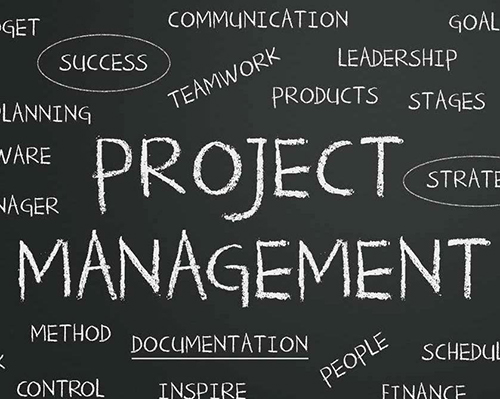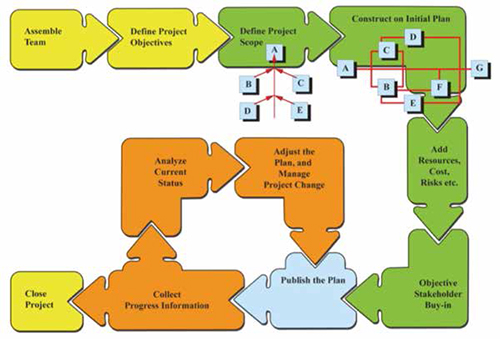
Project Management


In aviation, project management skills and techniques are often not formally used in daily aircraft operations. However, large MROs, manufacturers and repair stations often have formal project managers. Just like with leadership and management skills, employees are often not properly trained to perform effective project management. Are project management skills required in order to efficiently manage every aspect in an aviation operation? The answer is definitely! This means every DOM, manager, supervisor, and even technicians should use a formal project management process.
The Eight Skills Needed to Become a Project Manager
A project manager must have leadership, management and problem-solving skills. Project managers are there to plan and manage the work, NOT to do the work. Read on for a list of skills needed to become an effective project manager:
1. Be a Leader and a Manager
Leaders share and communicate a common vision. They gain agreement and establish the forward direction. They motivate others. Managers are results driven and focus on getting work done against agreed requirements. A good project manager will constantly switch from being a leader to a manager as the situations require.
2. Be a Team Builder and a Team Leader
Because projects are often cross functional (in that they use people who may not have worked together before), it is up to the project manager to set the “tone” of the team, and to lead them through the various team development phases to the point where they perform as an efficient team. The team individuals often have their own line manager, so the project manager has no implied authority — yet still needs to motivate the individuals. This is particularly true in a “matrix” organization.
3. Be a Problem Solver
This is a skill that can be learned; it just needs a little investigative work up front. You will first want to identify the possible “causes” that lead to the problem “symptom.” Causes can come from a variety of sources. Some are:
• Interpersonal problems
• Internal sources
• External sources
• Technical sources
• Management sources
• Communication
• Opinions or perceptions
Having found the root cause, the next step is to analyze possible options and alternatives and determine the best course of action to take. Take care to agree what “best” really means here!
4. Be a Negotiator and Influencer
Negotiation is working together with other people with the intention of coming to a joint agreement. It doesn’t have to be a power struggle. For example, try getting one of the team members to work late to meet a deadline when they would prefer to go to the ball game. For this you need to have some influencing skills. Influencing is getting events to happen by convincing the other person that your way is the better way — even if it’s not what they want. Influencing power is the ability to get people to do things they would not do otherwise.
5. Be an Excellent Communicator
Being a communicator means recognizing that it’s a two-way street. Information comes into the project and information goes out of the project. A good way of summarizing this is that all communication on your project should be clear and complete. As a project manager, you will have to deal with both written and oral communications. Some examples are documents, meetings, reviews, reports and assessments. A good mental guideline is “Who needs this information? Who gathers and delivers it? When or how often do they need it? In what form will I give it to them?”
6. Be a Good Organizer
Let’s just think of the aspects you will need to organize: project filing including all documentation, contracts, e-mails, memos, reviews, meetings, specialist documents, requirements and specifications, reports, changes, issues, risks, etc. It’s almost impossible to stay organized without having time-management skills.
7. Be a Competent & Consistent Planner
The skill of planning can’t be underestimated. There are known and logical steps in creating plans. As a project manager, you will certainly own the project plan, but there may be other plans depending upon the project. Just be aware that planning should become second nature to you. Two aspects need to be mentioned here:
• Plans are always documents. Don’t fall into the trap of thinking that, for example, a Gantt chart is not a plan — it’s only a schedule diagram.
• Successful teams deliver successful projects. Always use the team to help create the plan unless there is a good reason why not, such as commercial confidentiality or contractual conditions.
8. Set up & Manage Budgets
At the heart of this is the skill of estimating, particularly cost estimates. The project manager will nearly always need certain knowledge of financial techniques and systems along with accounting principles.
Part of the project plan will be something called the spend plan. This will show the planned spend against a timescale. The project manager will want to get involved in purchasing, quoting, reconciling invoices, timesheets, labor costs, etc. The project manager then needs to establish what has actually happened as opposed to what was planned and to forecast the expected final costs. Normally accounting and project management tools will help, but remember the “garbage in and garbage out” rule.
Project Management Outline
Regardless of where you’re flexing your project management muscles, most people follow a similar five-phase process.
1. Initiation
• Project management overview
• Project management knowledge areas
• Project management process groups
• Audit engagement overview
• Adding value — achieving audit engagement success
• Deliverables and milestones
The first phase of project management is typically initiation. The project goal is established during the initiation phase. If you don’t start a project with the correct goal or goals, it’s unlikely you will accomplish the goal. Establishing a project goal is a team activity because it’s important that your team members understand what everyone is working towards.
This is also the time when the project manager will work with the project stakeholders to make sure everyone understands and agrees to the scope of the project. At the end of the initiation phase, you should have the project charter — this is a document that contains a list of goals and a short statement, like a mission statement, providing a detailed overall goal. Within this statement, you should include a definition of success.
To begin this process, start with a good old-fashioned brainstorming session. This is not a list of the things that need to happen to accomplish your goal, but rather a list of end results. For example, “performing main rotor hub inspection” is a task, but “completing a 2,400-hour inspection” is a goal.
2. Planning
• Project planning
• Audit engagement planning
• Scope management
• Time management
• Cost management
• Plan quality
• Human resource planning
• Communications
• Risk management
Once you’ve defined your project deliverables, you’re ready to enter the planning phase. Once in this phase, you’re ready to create the specific list of things that need to happen in order for your goal to be met.
Unlike goals, tasks are identifiable steps that can be sequenced on a timeline or calendar and assigned to specific people. Tasks should be clear and simply stated. If a task cannot be described in a sentence or two, you might want to break it up into two or more smaller tasks.

Tasks should always be confined to a known time frame (typically between two hours and two weeks) and should include only work-related aspects. A project’s tasks are associated with a specific person or group and should have a single point of sign off.
Once you have your list of tasks, you can begin to assemble them in a workable order working to create milestones within the tasks, or measurable points of completion. In terms of project management basics, this order is defined as your work breakdown structure (WBS).
3. Execution or Implementation
• Project execution
• How to work together as a team
• Leading project teams
• Team dynamics
Once the project initiation and planning phases have been completed, you can move to the execution phase of your project. Some project managers refer to this phase as the implementation phase. This is where your project tracking software comes in.
The right software can help project managers track their tasks before, during and after the project. It can also help them manage their resources to ensure no one is over allocated or working overtime. It can help track company holidays and personal time off through the use of calendars. And, it can track all of the cost data — from equipment rental to personnel salary.
4. Monitoring and Controlling
• Scope management
• Change management
• Time and cost management
• Monitoring performance
• Monitoring risk
• Project closeout
The fourth phase of project management is closely tied to the execution phase. That’s because the art of project management can feel a little like a never-ending loop. You plan your project in phase two and execute your plan in phase three. Unfortunately, when you get to phase four (monitoring of the project progress), you realize your execution did not go according to the plan. Often, this requires a project manager to rework the plan, then execute again.
5. Closing and Next Step
• Putting it all together
• Next steps in implementation
Once the project is complete, project managers are responsible for providing detailed summary reports that include overall costs and resource work. Many project management software programs are fully capable of providing such reports. This type of detailed information lays the groundwork for future projects.
 JD McHenry is the president/CEO of Global Jet Services. He has been involved in numerous aviation maintenance and flight operation programs for over 37 years. McHenry holds A&P, IA, Pilot, and Doctorate of Business Management. Global Jet Services is the leader in on-site maintenance training providing high quality, flexibility and cost effectiveness. The maintenance customers are its #1 priority. Both JD’s and Global Jet Services goal is to lead the way in aviation maintenance training standards.
JD McHenry is the president/CEO of Global Jet Services. He has been involved in numerous aviation maintenance and flight operation programs for over 37 years. McHenry holds A&P, IA, Pilot, and Doctorate of Business Management. Global Jet Services is the leader in on-site maintenance training providing high quality, flexibility and cost effectiveness. The maintenance customers are its #1 priority. Both JD’s and Global Jet Services goal is to lead the way in aviation maintenance training standards.
